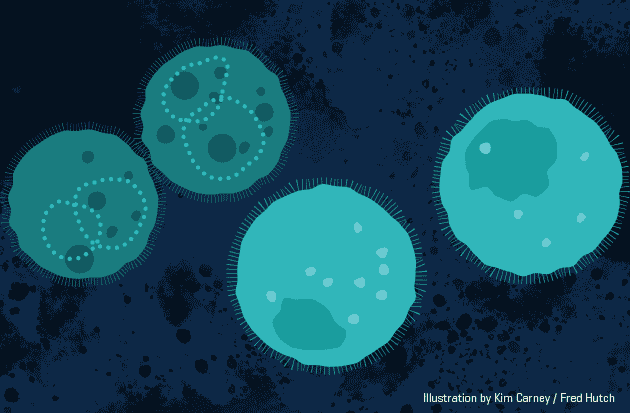Aug 31 2017
A new approach to cell therapy that is as simple as ‘just add water’ has been presented by a study published in the August 30th edition of Nature Communications.
 Biodegradable nanoparticles (orange) carry short-lived gene therapy to specific cells (light teal), giving them disease-fighting properties. Kimberly Carney / Fred Hutch News Service
Biodegradable nanoparticles (orange) carry short-lived gene therapy to specific cells (light teal), giving them disease-fighting properties. Kimberly Carney / Fred Hutch News Service
A new biomedical tool that makes use of nanoparticles that deliver transient gene changes to targeted cells will be able to produce therapies for different diseases, including HIV, diabetes and cancer. These therapies will be cheaper and faster to develop, and more customizable.
Developed by Researchers at Fred Hutchinson Cancer Research Center, this tool was tested in preclinical models.
Our goal is to streamline the manufacture of cell-based therapies. In this study, we created a product where you just add it to cultured cells and that’s it — no additional manufacturing steps.
Dr. Matthias Stephan, Lead Author and a Faculty Member, the Fred Hutch Clinical Research Division and an Expert in developing biomaterials
A nanoparticle delivery system was developed by Stephan and his colleagues in order to extend the therapeutic potential of messenger RNA, which is capable of delivering molecular instructions from DNA to cells in the body, and then directing them to produce proteins to fight and prevent disease.
The Researchers’ approach was designed such that it can zero in on particular cell types —blood stem cells and T cells of the immune system — and then directly deliver mRNA to the cells, activating short-term gene expression. It is called "hit-and-run" genetic programming since the transient effect of mRNA does not alter the DNA, but it is sufficient to develop a lasting impact on the therapeutic potential of the cells.
Three examples were employed by Stephan and colleagues in the Nature Communications paper in order to demonstrate their technology:
- A gene-editing tool was carried by nanoparticles to T cells of the immune system that cut out their natural T-cell receptors, and was then paired with genes encoding a “chimeric antigen receptor” (CAR), a synthetic molecule designed for attacking cancer.
- Nanoparticles, targeted to blood stem cells, were provided with mRNA that allowed the stem cells to multiply and then replace blood cancer cells with healthy cells when employed in bone marrow transplants.
- Nanoparticles targeted to CAR-T cells and comprising of foxo1 mRNA, which signals the anti-cancer T cells to develop into a type of “memory” cell that is extremely aggressive and destroys tumor cells in a more effective manner and maintains anti-tumor activity for a prolonged time period.
Other attempts that focused on engineering mRNA into disease-fighting cells have been complicated. The large messenger molecule degrades rapidly even before it can have an effect, and the body’s immune system recognizes it as foreign — not approaching from DNA in the nucleus of the cell — and thus destroys it.
A workaround to those hurdles was devised by Stephan and his Fred Hutch collaborators.
“We developed a nanocarrier that binds and condenses synthetic mRNA and protects it from degradation,” Stephan said. The nanoparticle was surrounded with a negatively charged envelope with a targeting ligand fixed to the surface so that the particle selectively homes in and fixes to a specific cell type.
The cells swallow up the small carrier, which can be loaded with varied types of manmade mRNA.
If you know from the scientific literature that a signaling pathway works in synergy, you could co-deliver mRNA in a single nanoparticle. Every cell that takes up the nanoparticle can express both.
Dr. Matthias Stephan, Lead Author and a Faculty Member, the Fred Hutch Clinical Research Division and an Expert in developing biomaterials
The approach deals with mixing the freeze-dried nanoparticles with a sample of cells and water. Cells begin to show signs that the editing has taken effect within four hours. If needed, boosters can be given. The nanoparticles, produced from a dissolving biomaterial, are removed from the body like other cell waste.
“Just add water to our freeze-dried product,” Stephan said. Since it is built on current technologies and does not need knowledge of nanotechnology, he hopes for it to be an off-the-shelf way for Cell-therapy Engineers to produce new approaches to treating different diseases.
The approach can possibly replace labor-intensive electroporation, a multistep cell-manufacturing technique that needs clean rooms and specialized equipment. All the handling leads to destroying several of the cells, and this restricts the amount that can be used in treatments for patients.
The nanoparticle system that is gentler to cells was developed by the Fred Hutch team and proved that up to 60 times more cells survived the process when compared with electroporation. This is a significant feature for guaranteeing that sufficient cells are viable when transferred to patients.
You can imagine taking the nanoparticles, injecting them into a patient and then you don’t have to culture cells at all anymore.
Dr. Matthias Stephan, Lead Author and a Faculty Member, the Fred Hutch Clinical Research Division and an Expert in developing biomaterials
The technology has been tested by Stephan in cultured cells in the lab, and it is not yet available as a treatment. Stephan is on the lookout for commercial partners in order to move the technology toward added applications and also into clinical trials where it could be established as a therapy.
The study was funded by the Bezos family, a National Institutes of Health Cancer Consortium grant, the National Science Foundation and the American Cancer Society.
The other Co-authors include Howard Moffett, Michael Coon, Stefan Radtke, Sirkka Stephan, Laura McKnight, Abigail Lambert, Barry Stoddard and Hans-Peter Kiem.
Note: Scientists at Fred Hutch were part of the process involving the development of these discoveries, and Fred Hutch and particular Scientists may financially benefit from this work in the future.